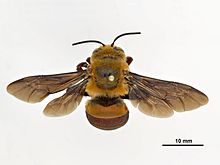Amegilla dawsoni
| Amegilla dawsoni | |
|---|---|
 |
|
| Scientific classification | |
| Kingdom: | Animalia |
| Phylum: | Arthropoda |
| Class: | Insecta |
| Order: | Hymenoptera |
| Family: | Apidae |
| Genus: | Amegilla |
| Species: | A. dawsoni |
| Binomial name | |
|
Amegilla dawsoni Rayment, 1951 |
|
Amegilla dawsoni, sometimes called the Dawson's burrowing bee is a species of bee that nests by the thousands in arid claypans in Western Australia. It is a long tongued bee, of the tribe Anthophorini and genus Amegilla, the second largest genus of the Anthophorini species.
The Dawson's burrowing bee is one of the largest Australian bee species, growing to be 23 millimetres (0.91 in) in length and 45 millimetres (1.8 in) in wingspan. With the exception of their faces, the bees are covered in brown fur, if male, or brown and white fur if female. They are similar in size and coloring to Australian carpenter bees.
They are known solitary nesters. Though each female bee will build her own nest, they aggregate in large communities that give the appearance of colonies. Their nests are dug into the ground, with individual capsules created for each brood cell. Each female will only breed once in their breeding season.
The males of the species are dimorphic, based on brood provisioning strategies during development. The larger males - called majors - tend to aggressively patrol emergence areas, and will compete in physical fights to mate with virgin or recently mated females. On the other hand, the smaller males - called minors - which make up 80% of the male population, will wait at the fringes of the emergence area and will mate only with females who are able to fly away unmated from the immediate vicinity of their natal nests. Females indicate receptiveness or lack of receptiveness to mating by emitting particular mixes of chemical signals based on whether she has mated previously.
The bee feeds only on 4 genera of plants located in the deserts of Western Australia. This resource pressure has been implicated in forcing the bees to be panmictic.
The Amegilla dawsoni is part of the tribe Anthophorini, the long tongued bees, and genus Amegilla. The Amegilla genus is the second largest group within the tribe Anthophorini, behind the genus Anthophora. The Amegilla genus has been divided into 11 subgenera, altogether containing over 250 individual species. The genus contains bees located purely in Old World, appearing throughout Europe, Africa and Asia, with one subgenus endemic to Australia.
The Amegilla and Anthophora genera are monophylic, based on a series non-homoplasious traits. Additionally, the Amegilla genus is strongly characterized by several autapomorphies, including a gonostylus, the male phallic organ, that is fused to the gonocoxite, or interior region of copulation, and a curved maxillary palpus with distinctive surrounding fringe. These traits when subjected to bootstrap analysis yielded 100% cladistic support.
...
Wikipedia
